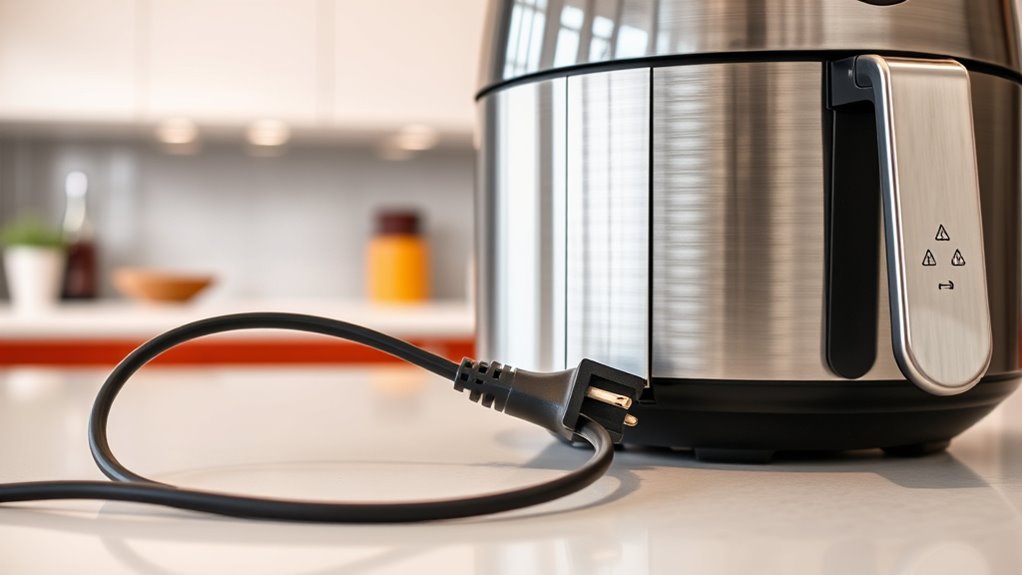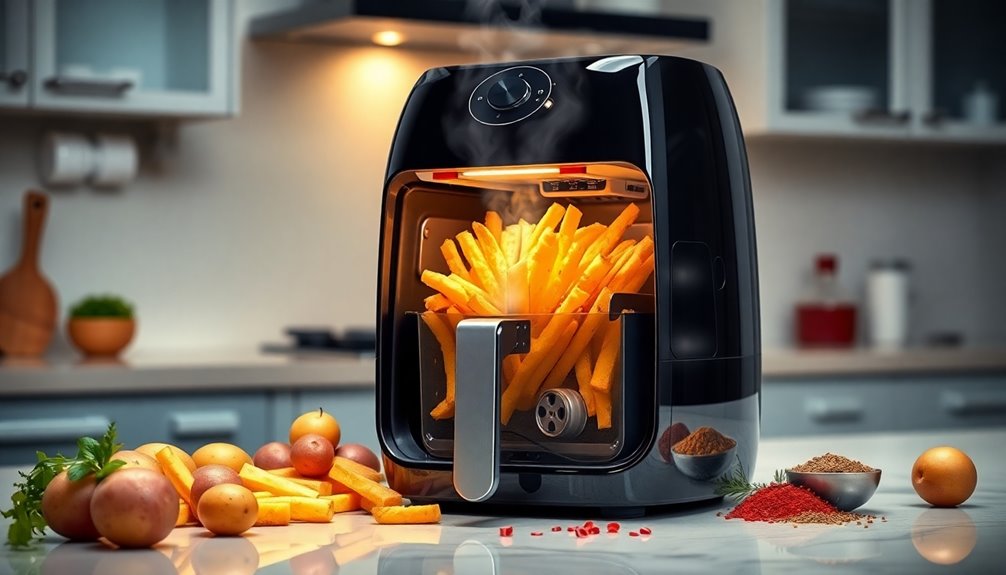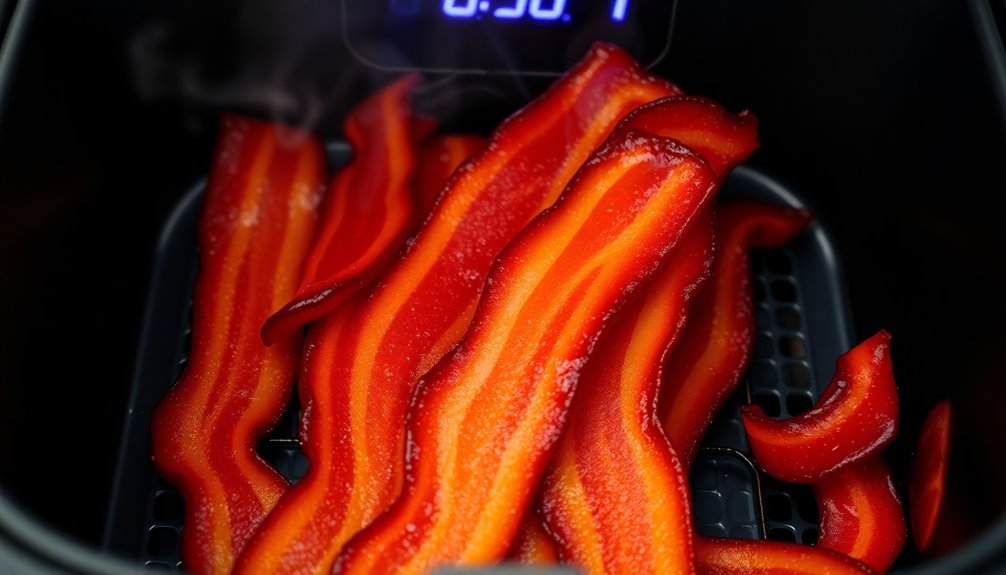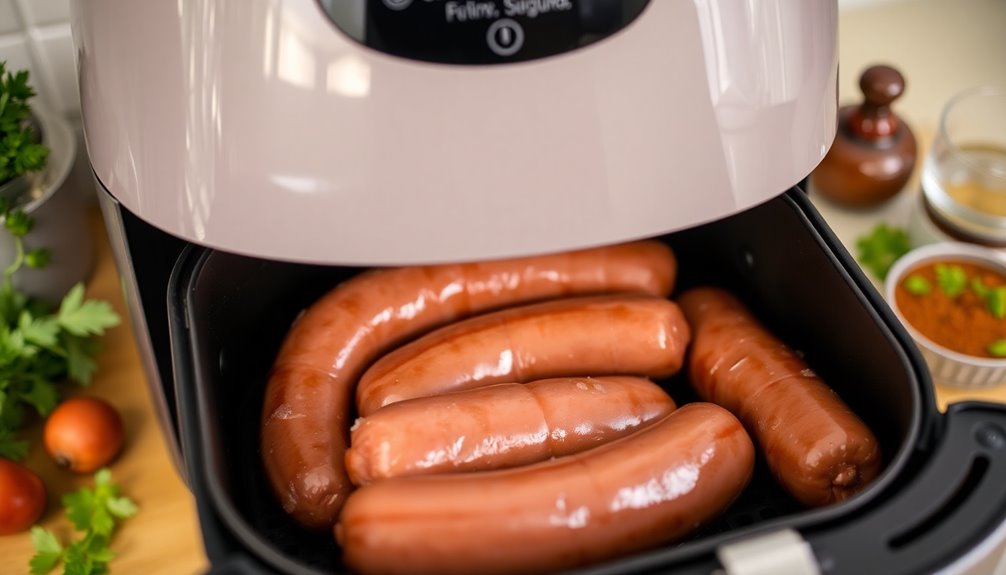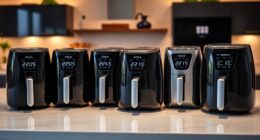To avoid electrical hazards with your air fryer, always use appliances on grounded outlets and avoid extension cords or multi-outlet strips rated for high wattage. Regularly inspect cords and plugs for damage, and replace if you notice frays or cracks. Keep the appliance away from water and guarantee proper placement with adequate ventilation. Unplug after use, and follow manufacturer safety tips to prevent overheating or fire risks. Keeping these precautions in mind will help you operate safely, and more tips await if you continue.
Key Takeaways
- Always use properly rated, grounded outlets and avoid extension cords to prevent overheating and electrical fires.
- Regularly inspect cords, plugs, and electrical connections for damage; replace damaged parts immediately.
- Place the air fryer on stable, heat-resistant surfaces with at least 5 inches of clearance for ventilation.
- Keep water away from electrical components and unplug the appliance after use to prevent shock risks.
- Follow manufacturer instructions for setup, cleaning, and maintenance to ensure safe operation.
Recognizing Common Electrical Hazards in Air Fryers
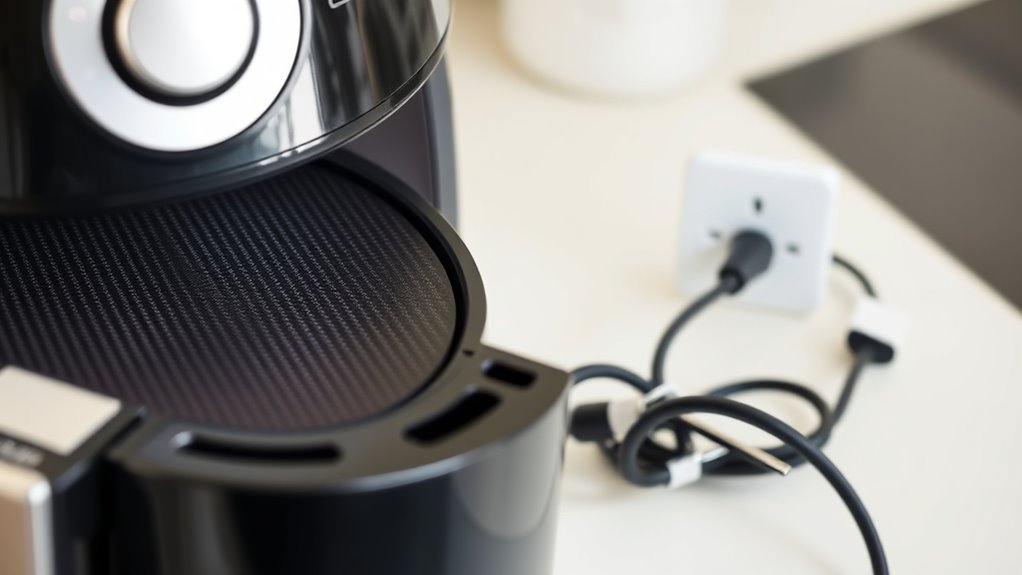
Electrical hazards are among the most common risks associated with air fryers, especially when you’re not careful. Using an extension cord that isn’t rated for high wattage (1200–1800W) can easily lead to overheating and increase the risk of electrical fires. Always inspect your cords and plugs for fraying, cracks, or other damage, as faulty wiring can cause sparks or shorts. Avoid plugging your air fryer into multi-outlet strips or extension cords, since overloading circuits can trigger electrical malfunctions or fires. Keep your appliance away from water sources and damp environments, which heighten shock risks. Recognizing these hazards helps you prevent dangerous situations and ensures safer operation of your air fryer. Regular checks and proper setup are key to avoiding electrical fires. Proper electrical setup is essential for safe appliance operation and minimizing hazards. For added safety, consider using grounding procedures to further reduce electrical risks. Ensuring your power supply is appropriate for your appliance can also prevent overloads and potential hazards. Additionally, consulting certifications and endorsements from safety organizations can help verify the safety standards of your air fryer. Being aware of overloading circuits and avoiding the use of incompatible cords can significantly reduce risk.
Proper Setup and Placement of Your Air Fryer

To guarantee safe use, place your air fryer on a stable, heat-resistant surface with at least 5 inches of space behind it for proper ventilation. Always plug it directly into a wall outlet, avoiding extension cords or multi-outlet strips to reduce electrical risks. Keep the appliance away from water sources and flammable objects, and regularly check the power cord for damage. Be aware that electrical hazards can occur if the appliance is not set up correctly. Additionally, understanding city dynamics can help prevent hazards related to inadequate space or improper placement in busy or crowded areas. Being mindful of electrical safety guidelines ensures a safer cooking environment and reduces the risk of accidents. Proper setup also helps prevent rhythm failure in electrical systems that can cause power interruptions. Proper placement and regular inspection contribute to the overall appliance longevity, ensuring your air fryer remains safe and functional over time.
Stable, Heat-Resistant Surface
Ensuring your air fryer is placed on a stable, heat-resistant surface is essential for safe and effective operation. A stable surface prevents tipping, spills, or damage caused by heat exposure. It should be able to withstand temperatures of at least 428°F, matching the appliance’s interior temperature. Additionally, maintaining at least 5 inches of clearance behind and around vents promotes proper airflow and prevents overheating. Avoid placing your air fryer on plastic, paper, or flammable materials that could melt or ignite from the heat. Regularly check that the surface remains stable, free of debris, and unobstructed to ensure safe operation. Proper setup on a heat-resistant, stable surface minimizes electrical hazards and keeps your kitchen safe. Always verify that your electrical connections are secure and compliant with safety standards to prevent potential hazards. Consider kitchen organization to reduce clutter and potential fire risks around appliances. Remember that creative problem-solving can be applied when troubleshooting any setup issues to ensure safety and efficiency. Furthermore, considering lifestyle factors such as kitchen organization and workspace ergonomics can enhance overall safety during your cooking routines.
Adequate Clearance Space
Have you positioned your air fryer with enough space around it? Ensuring proper clearance is essential for safe operation. Keep at least 5 inches of space behind the air fryer to the wall or objects, allowing airflow to prevent overheating. Make sure the power cord isn’t stretched or pinched, reducing fire risks and electrical hazards. Place the appliance on a stable, heat-resistant surface free of clutter and flammable items like paper towels or curtains. Adequate space around the vents and back panel is important since surfaces can reach over 200°F during use. Also, avoid water sources nearby to prevent electrical issues. Proper setup of your air fryer with enough clearance minimizes risks and optimizes performance, keeping you safe while enjoying delicious meals. Security considerations are also important when using electrical appliances to prevent potential hazards. Additionally, regularly inspecting electrical cords and connections can help identify potential electrical hazards before they become serious issues. To further ensure safety, familiarize yourself with proper appliance placement tips for appliance maintenance and risk prevention.
Proper Electrical Outlet Use
Placing your air fryer in the right electrical setup is essential for safe operation. Always plug it into a grounded outlet to prevent electrical shock and ensure proper grounding. Avoid using extension cords or multi-outlet strips, as these can overload the circuit and increase fire risk. If needed, use a heavy-duty extension cord rated at 20 amps with sufficient wattage capacity (up to 1800W). Make sure the appliance is on a stable, heat-resistant surface away from water, flammable materials, and high-traffic areas. Regularly inspect the power cord and plug for damage, replacing them immediately if you notice fraying or cracks. Keep the outlet clear of clutter to maintain safety and proper grounding. Incorporating mindfulness techniques can help you stay attentive to potential hazards and ensure your kitchen remains a safe environment. Additionally, understanding electrical safety principles can further reduce the risk of accidents and electrical hazards. Being aware of AI security developments can also inform safer smart kitchen innovations and safeguards. Proper circuit capacity assessment ensures your electrical system can handle the load without overloading, reducing risk.
Inspecting and Maintaining the Power Cord and Plug

Regularly inspecting your air fryer’s power cord and plug is essential for safe operation. Check the power cord for fraying, cracks, or other damage, as damaged cords can cause electrical shorts or fires. Verify the plug fits securely into the outlet without looseness or sparking, indicating a proper connection. Avoid using extension cords not rated for high wattage appliances like air fryers, since under-rated cords can overheat and pose fire risks. Replace the power cord immediately if you notice exposed wires, burn marks, or melting, even if the damage seems minor. Always unplug the air fryer when not in use or before cleaning to prevent accidental electrical shock or short circuits. Proper maintenance of the power cord and plug keeps your air fryer safe and functioning correctly. Additionally, being aware of cybersecurity vulnerabilities related to smart appliances can help protect your home network from potential threats.
Safe Handling and Cooling Procedures During Use

Unplug your air fryer immediately after cooking to prevent electrical overheating and reduce fire risks. Always follow proper cooling procedures before handling or cleaning to avoid electric shock. Wait at least one hour for all parts to cool completely, especially the basket and interior surfaces. Use oven mitts or heat-resistant gloves when touching hot surfaces to protect yourself during removal or cleaning. Keep the appliance on a stable, heat-resistant surface and stay clear of water or wet areas during operation to prevent electrical hazards. Regularly inspect the power cord for damage or fraying, replacing it if needed.
- Allow sufficient cooling time before handling
- Use protective gear when touching hot parts
- Keep the appliance dry and on stable surfaces
Avoiding Overloading Outlets and Extension Cords
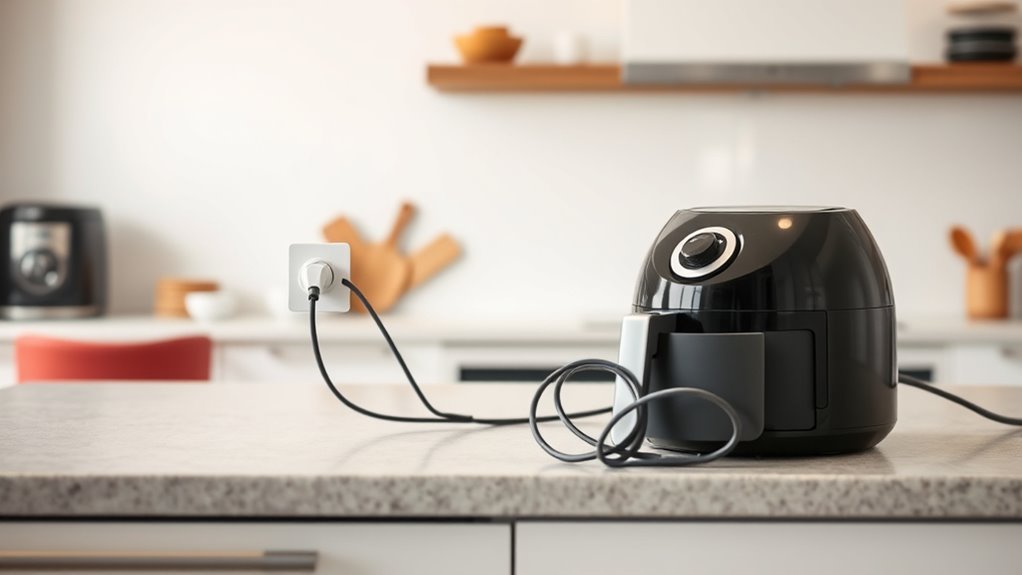
To prevent electrical hazards when using your air fryer, it’s essential to avoid overloading outlets and extension cords. Never plug high-power appliances directly into extension cords, as this can cause overheating and increase the risk of electrical fires. Use only heavy-duty extension cords rated for at least 20 amps or 10 gauge wire if you need to connect appliances requiring 1200-1800 watts. Avoid daisy chaining multiple extension cords or plugging several devices into a single outlet, which can overload the circuit. Regularly inspect extension cords for fraying, cracking, or damage, and replace any damaged cords immediately. Remember, overloading outlets by connecting multiple high-demand appliances at once can cause overheating and pose serious fire risks. Keep safety a priority by managing your power sources carefully. Additionally, choosing vetted extension cords can ensure better safety standards and reduce risks. Properly rated cords help prevent electrical overloads and maintain safe operation.
Selecting and Using the Right Power Sources

Always plug your air fryer directly into a wall outlet to guarantee safe operation. If you must use an extension cord, choose a heavy-duty, 20-amp rated cord and avoid overloading it. Regularly check cords for damage to prevent potential electrical hazards.
Proper Outlet Connection
Using the correct power source is essential for safe and efficient operation of your air fryer. Always plug your appliance directly into a grounded, 120V outlet to reduce electrical hazards. Preferably, use a dedicated wall socket rather than extension cords or multi-outlet strips, especially those not rated for high wattage. Before plugging in, check that the outlet and plug are free of damage, corrosion, or loose connections. This ensures a secure connection and prevents potential short circuits. Overloading the circuit can cause overheating and electrical faults, so verify that the outlet can handle the appliance’s wattage, usually between 1200 and 1800 watts. Proper outlet connection minimizes risks and keeps your air fryer operating safely and effectively.
- Use a dedicated wall outlet for your air fryer
- Ensure the outlet and plug are undamaged
- Avoid extension cords and multi-outlet strips
Extension Cord Precautions
Selecting the right extension cord is essential for safe air fryer use, especially given its high power demands. Use a heavy-duty extension cord rated at 20 amps with 10-gauge wire to handle the 1200–1800 watt draw. Always inspect the cord for fraying, cracks, or damage before plugging in; replace damaged cords immediately to prevent electrical hazards. Avoid overloading by not plugging multiple high-power appliances into the same extension cord, as this can cause overheating and increase fire risk. Never use extension cords that are too long or undersized, since they can lose power over distance and become unsafe. Whenever possible, plug your air fryer directly into a wall outlet to minimize electrical risks associated with improper power sources.
Identifying Signs of Damage and When to Replace Components

Regularly inspecting your air fryer for signs of damage is essential to guarantee safe operation. Damaged components can cause electrical hazards, so it’s crucial to recognize warning signs early. Look closely at the power cord for fraying, cracks, or exposed wires, and replace it immediately if you notice any damage. Check the plug and cord for scorching, melting, or burn marks, which indicate electrical issues. During operation, listen for sparking or crackling sounds and observe any looseness in the outlet or plug connections. If you spot any signs of damage, cease using the appliance and replace the affected components promptly. This proactive approach helps prevent electrical fires and keeps your air fryer functioning safely.
- Frayed or cracked power cords
- Burn marks or melting on the plug or cord
- Loose connections or sparking during use
Safe Cleaning Practices to Prevent Electrical Risks
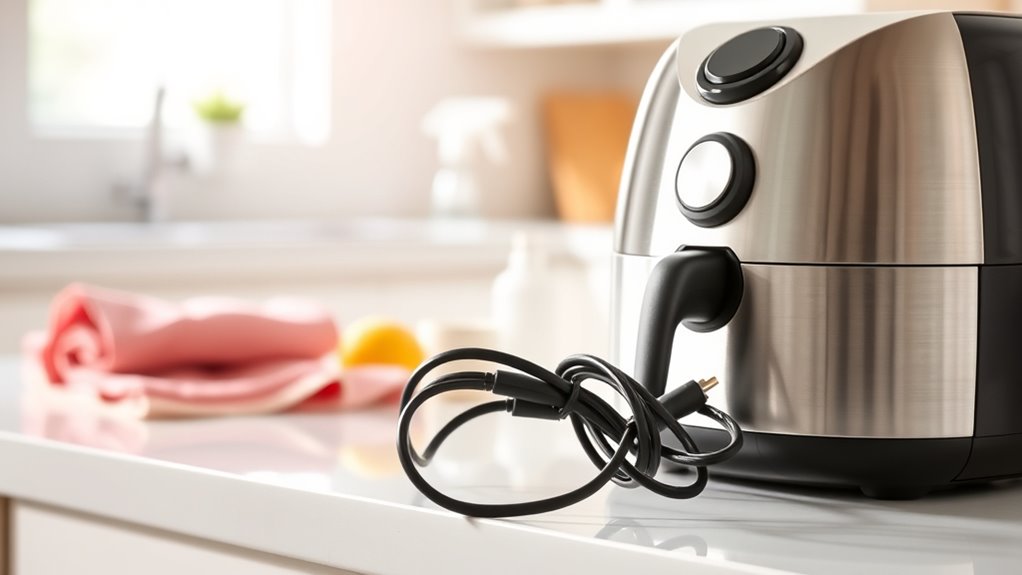
Before cleaning your air fryer, always unplug it to avoid electrical shock. Use a damp cloth for the exterior and interior, but keep water away from electrical parts. Wash the basket and pan separately, making sure they’re dry before putting everything back together.
Proper Cleaning Procedures
To prevent electrical hazards, always unplug your air fryer before cleaning. This step guarantees no electrical shock occurs during maintenance. When cleaning, remove the basket and pan, then wash them with dish soap and water—avoid the dishwasher to prevent damage to electrical components. Use a damp, not soaked, cloth to wipe the heating element and exterior surfaces, being careful to prevent water from entering electrical parts. Regularly clean grease and burnt food residues from the basket, coils, and vents to reduce fire risks and keep your appliance safe. Ensure all parts are thoroughly dry before reassembling and plugging in your air fryer.
- Remove grease buildup regularly to keep parts clean and functioning smoothly
- Never soak electrical components or immerse the appliance in water
- Dry all parts completely before reassembly to prevent short circuits
Avoid Water Contact With Electronics
Since water and electrical components don’t mix, it’s essential to keep liquids away from your air fryer’s internal parts. Water contact with electrical hazards can cause short circuits, electric shocks, or damage to the appliance. Always unplug the air fryer and let it cool completely before cleaning. Use a damp, not soaked, cloth to wipe down the exterior and interior surfaces, avoiding direct contact with electrical parts like the heating element or wiring. Never spray or pour water near vents, control panels, or inside the basket where wiring may be exposed. Regularly inspect the power cord and plug for damage—do not attempt to clean with water if you notice fraying, cracks, or other electrical hazards. Keeping water away safeguards both your appliance and your safety.
Understanding Fire Risks and Prevention Strategies
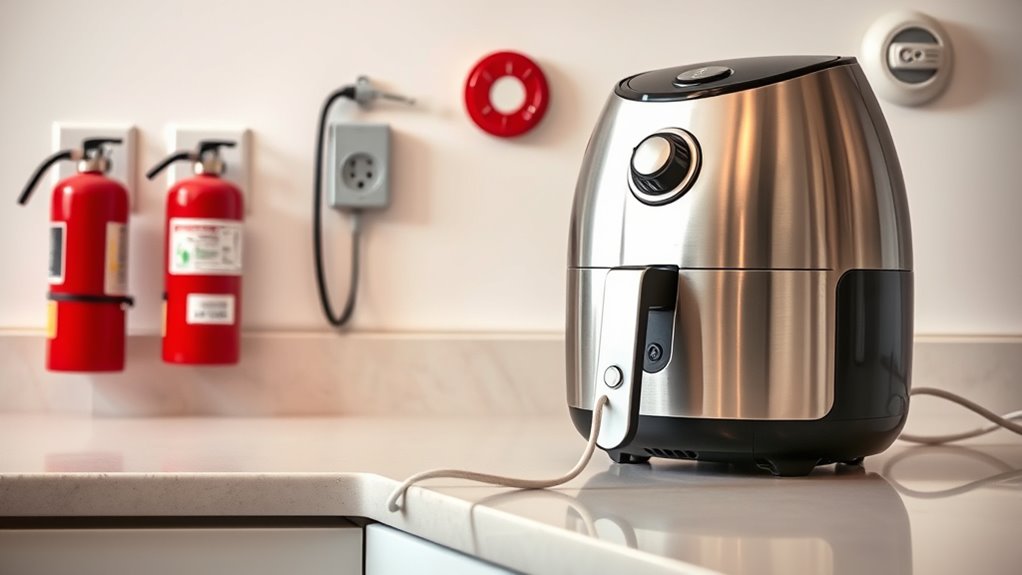
Understanding fire risks associated with air fryers is essential for safe use. Fire hazards can arise from overheating, smoke emission, or improper handling. Nearly 19% of UK adults have experienced such issues, often due to neglecting safety guidelines. To prevent fires, always follow the manual’s instructions, never leave the appliance unattended while in use, and avoid overfilling. Regularly inspect cords and plugs for damage, and ensure proper placement with adequate ventilation. By being proactive, you reduce the chances of electrical malfunctions that can lead to fires. Remember, most fire hazards stem from improper use or neglect. Staying vigilant and adhering to safety tips can considerably reduce your risk of household damage caused by air fryer fires.
Best Practices for Long-Term Safe Operation

Maintaining safe operation of your air fryer over time requires consistent attention to its condition and proper use. Regularly inspect the cord and plug for damage; replace them immediately to prevent electrical shocks and fires. Always unplug the appliance when not in use, and avoid extension cords rated below 20 amps or 10 gauge to avoid overheating. Keep the air fryer on a stable, heat-resistant surface with at least 5 inches of clearance for proper ventilation. Follow the manufacturer’s instructions carefully, especially for proper cleaning and maintenance, to prevent malfunctions. Use the table below as a quick reference:
| Practice | Purpose |
|---|---|
| Inspect cord regularly | Prevent wiring failures |
| Proper cleaning | Maintain electrical safety |
| Unplug when idle | Reduce electrical hazards |
Frequently Asked Questions
Is It Safe to Leave the Air Fryer Plugged In?
You might wonder if it’s safe to leave your air fryer plugged in. While it’s generally okay if your device is in good condition and used correctly, unplugging it after cooking is safer. Doing so reduces risks like electrical faults or overheating, especially with older or faulty models. Always check for damage and avoid using extension cords. For maximum safety, unplug your air fryer when not in use and inspect the cord regularly.
Are Air Fryers a Safety Hazard?
You might think air fryers are completely safe, but they can pose hazards if damaged or poorly maintained. If cords are frayed or wiring is faulty, overheating and sparks could start a fire. Always inspect your air fryer regularly, avoid using damaged cords, and skip cheap models. By staying vigilant, you guarantee your kitchen remains safe, and you enjoy healthy fried foods without risking electrical dangers.
Is It Safe to Leave a House With an Air Fryer On?
Leaving your house with an air fryer on isn’t safe. These appliances can overheat or malfunction, which may cause fires. Since they reach high temperatures and sometimes have faulty wiring, it’s best to unplug your air fryer after use. Always supervise its operation if you choose to leave it on temporarily, and place it on a heat-resistant, stable surface to minimize risks. Don’t leave it unattended for long periods.
How Far Should an Air Fryer Be From the Wall?
You should keep your air fryer at least 3 inches away from the wall to prevent heat buildup and guarantee proper airflow. Maintaining this distance helps avoid overheating and potential fire hazards. Additionally, leaving at least 5 inches behind the appliance allows for better airflow and cooling. Always follow your manufacturer’s guidelines for specific clearance requirements, as these recommendations optimize safety and performance for your particular model.
Conclusion
By following these safety tips, you can enjoy your air fryer without worrying about electrical hazards. While some might think regular maintenance is unnecessary, staying vigilant guarantees safe operation and prevents costly accidents. Remember, a well-maintained appliance not only extends its lifespan but also safeguards your home and loved ones. Prioritize safety, stay informed, and use your air fryer responsibly—because a little caution today keeps hazards at bay tomorrow.
